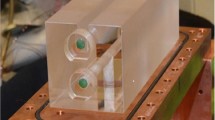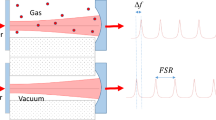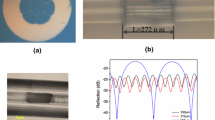Abstract
Many studies have recently been conducted to replace the mercury manometer that has been used as a national standard because of the prohibition of mercury. In particular, ‘the new realization of the Pascal’ by using photon technology shows some comparable results in terms of performance compared to the existing primary pressure standard based on the mercury manometer. In this study, we describe the development of a refractive index measuring system for precise vacuum pressure measurements to develop a mercury-free standard. If the refractive index of a medium is to be measured using a laser interferometer, designing a cavity as a pressure medium and a laser as a light source is important. We designed a Fabry–Perot (FP) cavity structure having two channels to calculate an arbitrary pressure by comparing the laser resonance frequency in a vacuum state, which served as a reference pressure, and that in an arbitrary pressure state. Zerodur was used as the material for the cavity. The cavity was designed to be a rectangular parallelepiped with a width of 50 mm and a length of 150 mm considering the wavelength (633 nm) of the He–Ne laser used as a light source, the pressure range to be implemented, and the implementation range of a single mode. We independently fabricated a single-mode (SM) He–Ne laser instead of a commercially available laser to modulate the frequency freely and to achieve a single polarization regardless of the quantum number. With our system, the beat frequency was measured to the internal pressure of a cavity. A 1 MHz beat frequency was found to be approximately equal to a pressure of 1 Pa.
Similar content being viewed by others
Avoid common mistakes on your manuscript.
1 Introduction
The measurement accuracy at low vacuum pressure is important in terms of directly affecting the measurement accuracy in the mid-vacuum and the high-vacuum ranges; thus, international comparison is the most active for this range. In addition, low vacuum pressure has been used for biochemical and medical research, refrigeration and internal combustion engines, factory production lines, and flow and depth measurements. For weather forecasts, safety of energy-related projects, and instruments in high-performance aircraft in particular, the pressure in this range must be measured with high accuracy.
For the past 400 years, a mercury manometer has been the primary pressure standard for low vacuum pressure [1]. However, the use of mercury is prohibited through international conventions such as those of the European Union, the USA, and the United Nations Environmental Program. Therefore, in the field of low vacuum studies and applications, a need exists for a primary standard that does not use mercury. This has necessitated ‘a new realization of the Pascal’ in conjunction with the density, temperature, refractive index of the gas, and the Boltzmann constant [2].
In the 2000s, many studies were conducted to calculate the pressure by using a Fabry–Perot (FP) cavity at a constant temperature to measure the refractive index in the FP cavity [3,4,5]. If the pressure inside the cavity changes, the density of the gas changes; accordingly, the refractive index changes. As a result, a change in the refractive index results in a change in the resonance frequency. Therefore, if we can simultaneously measure the laser resonance frequency in both a reference vacuum state and under an arbitrary pressure, calculating an unknown arbitrary pressure becomes possible. Many studies on calculating the pressure through a refractive index measurement and the detailed equations can be found in the literature [3].
Recently, ‘a new realization of the Pascal’ by using photon technology showed comparable results in terms of performance compared to the existing primary standard based on a mercury manometer [5]. With photon technology, the resolution is improved by 20 times, the response time of the detection is 100 times faster, the measurable pressure range is extended by 100 times or more, and the technology is improved in terms of both reproducibility and hysteresis. In this study, we describe a refractive index measuring system for precise vacuum pressure measurements that was developed as a mercury-free standard.
2 Experiments
One of the methods to measure the refractive index precisely is to use a FP cavity [6,7,8,9,10]. The refractive index has the following relationship between the frequency f of the laser locking the gas-filled FP cavity:
where m is the number of modes, n is the refractive index, L is the length of the cavity, c0 is the speed of light, and γ is the ratio between the spatial mode and the longitudinal mode. When the refractive index of the gas in the cavity changes, the optical frequency of the laser must change at the same rate as the refractive index to maintain the resonance.
If the refractive index of a medium is to be measured using a laser interferometer, designing a cavity and a laser as a light source is important.
2.1 Fabrication of a cavity
In this study, we designed a FP cavity structure having two channels to calculate an arbitrary pressure by comparing the laser resonance frequency in a vacuum state, which is the reference pressure, and that in an arbitrary pressure state. We designed the FP cavity through an optical analysis. As the material for the cavity, Zerodur (manufactured by Schott) was used, which has a thermal expansion coefficient of 1 × 10–8/K.
Mirrors for reflection and resonance of the He–Ne laser as a light source were attached to both ends of the FP cavity. One mirror was a flat type, and the other was a concave type. The mirrors attached to both ends of the FP cavity were coated to reflect more than 99.7% of the He–Ne laser used. For an accurate resonance in the cavity, the radius of curvature of the mirror, which was calculated using a Gaussian beam chart, is very important. Also, the finesse suitable for the mirror was calculated by considering the reflectance of each mirror:
where R1 and R2 are reflectivities of the mirrors attached to the two ends of the FP cavity.
2.2 Fabrication of a SM polarized laser
We independently fabricated a SM He–Ne laser instead of using a commercially available laser because when using a commercial He–Ne laser, modulating the frequency freely is not easy and obtaining a single polarization regardless of the quantum number is challenging. When the polarization is changed according to the quantum number, due to the anisotropy of the cavity mirror, the optical length will change even though the mechanical length of the resonator length L does not change which is a problem. Therefore, using a commercial laser tube for an iodine (I2) stabilized He–Ne laser, we adjusted the Brewster's angle to cause the laser to have a single polarization regardless of the quantum number. In particular, Zerodur was used to minimize the distance between the two mirrors. In addition, a lead zirconate titanate (PZT) module (manufactured by PI Co.), which can change the length of the cavity, was attached to the plane mirror jig for frequency modulation. The angle adjustment jig was placed on the laser tube and the plane mirror to focus the light between the two mirrors, and a dummy commercial He–Ne laser was attached to find the resonance conditions (Fig. 1).
2.3 Setup of the laser interferometer
We designed a laser interferometer that locked the fabricated SM He–Ne laser into a FP cavity. The light emitted from the laser passes through the isolator, which blocks the light generated by reflection, and through the electro-optic-modulator (EOM), which creates a side band. It then passes through the polarization-beam-splitter (PBS), the λ/4 wave plate, and the focus lens in turn, and enters the resonator. The light generated through the cavity is reflected and passes through the focal lens and the λ/4 wave plate once more to change the polarization. The PBS reflects this light and inputs it to the lock-in amplifier through a photodiode. Also, the phase-delayed signal is sent to the lock-in amp through a function generator. Finally, the proportional-integral (PI) controller maintains the resonance through a PZT control based on the error signal obtained from the lock-in amplifier (Fig. 2).
Using the manufactured cavity, the SM He–Ne laser, and the interferometer, we measured the change in the beating frequency against the change in the internal pressure of the cavity at pressures from 360 to 480 Pa. We changed the internal pressure of the cavity and compared the reading values of the internal pressure by using a capacitance diaphragm gauge (CDG) with the beating frequency from the interferometer.
3 Results and discussion
3.1 Fabrication of a cavity
Figure 3 shows the fabricated FP cavity. The FP cavity was a rectangular parallelepiped with a width of 50 mm and a length of 150 mm; it has a rectangular channel with a width of 7 mm and a height of 11 mm at the upper part and a circular channel with a diameter of 7 mm at the bottom part. The mirrors attached to two ends of the FP cavity were coated to reflect more than 99.7% of the He–Ne laser used, and one side was made to have a flat shape and the other to have a concave shape.
The length of the cavity was designed to be 150 mm considering the wavelength (633 nm) of the He–Ne laser used as the light source, the pressure range to be implemented, and the implementation range of a single mode. When the stability diagram (Fig. 4) is considered, the designed length of 150 mm appears to be suitable for the cavity to work as a stable resonator [11].
The radius of curvature of the mirror was calculated using a Gaussian beam chart [12]. We designed a lens with a focal length of 250 mm and a concave mirror with a radius of curvature of 370 mm. In addition, the finesse suitable for the mirror was calculated by considering the reflectance of each mirror (Eq. 2). The higher the finesse is, the better the optical performance is. However, designing the finesse to have an optimum value considering reflectance is better because it becomes more sensitive to the environment such as external pollution as the finesse becomes higher. In this study, we designed the finesse to have a value of 1500 by using Eq. 2.
The mirror was attached to the FP cavity by using an optical contact method without epoxy. Because one of the two channels of the FP cavity must maintain a vacuum state (a pressure of 10–2 Pa or less), the degree of vacuum in the fabricated cavity was measured. In general, many chemical bonding methods with epoxy are used, but in this case, such an approach may be a problem due to the outgassing from the epoxy when the vacuum is extracted. The final fabricated cavity exhibited a minimum pressure of about 3 × 10–3 Pa (about 1.7 × 10–5 Torr) when continuously evacuated for 12 h even though we adopted the epoxy-free optical contact method. This showed that in our case the optical contact method is applicable as a method for bonding the mirrors to the cavity.
3.2 Fabrication of the SM He–Ne laser
We independently fabricated the SM He–Ne laser by using a commercial laser tube (Fig. 5). To evaluate the characteristics of the fabricated SM He–Ne laser, we used a spectrum analyzer to measure the beating frequency with the reference I2 stabilized He–Ne laser. In our study, the free spectral range (FSR) is an important parameter in the laser performance. The FSR was approximately 890 MHz, similar to the design value of 903 MHz. The laser showed a beating frequency with a ± 2 MHz stability with respect to the I2 stabilized He–Ne laser. This appears to be due the fluctuation of the environmental temperature. In order to improve the signal stability, we plan to increase the signal size by reducing the light reflectance of the cavity from 99.97 to 99.85% and to stabilize the environmental temperature by using an outer case for the fabricated SM He–Ne laser.
3.3 Setup of the interferometer and measurement of the beating frequency according to the internal pressure of the cavity
We built a laser interferometer as shown in Fig. 6. With this system, the internal pressure of the cavity over a pressure range from 360 to 480 Pa was measured using a capacitance diaphragm gauge (CDG) while the laser frequency was locked to the resonant frequency of the upper cavity. A spectrum analyzer was used to measure the beating frequency relative to a reference I2 stabilized He–Ne laser. The system could measure a range of 120 Pa without changing the mode number m. Figure 7 shows the beat frequency measured using the spectrum analyzer and the pressure measured using the CDG. 1 MHz beat frequency was found to be approximately equal to 1 Pa in pressure, which is very similar to the results published by the National Institute of Standards and Technology (NIST) [5] and National Metrology Institute of Japan (NMIJ) [6].
4 Conclusion
In this study, we designed a system to measure the pressure by using the refractive index. The contributions of this study are summarized as follows:
-
1)
We fabricated a FP cavity having a rectangular parallelepiped shape with a width of 50 mm and a length of 150 mm with two channels (one for the reference vacuum state and the other for measuring pressure).
-
2)
We independently manufactured a SM He–Ne laser without using a commercial laser as a light source to allow easy frequency modulation and a single polarization regardless of the quantum number. The beating frequency was ± 2 MHz compared to an I2 stabilized He–Ne laser.
-
3)
With the manufactured system, the beating frequency was measured for changing the internal pressure. When the internal pressure changed 1 Pa, the frequency changed 1 MHz.
In the future, we will calculate the arbitrary pressure of the cavity by using a measurement of the resonance frequency of the cavity and improve the temperature stability by a using double-chamber structure with an outer aluminum chamber.
References
H.M. Akram, M. Maqsood, H. Rashid, Rev. Sci. Instrum. 78(7), 75101 (2007)
J. Hendricks, Nature Phys. 14, 100 (2018)
P.F. Egan, J.A. Stone, J.H. Hendricks, J.E. Ricker, G.E. Scace, G.F. Strouse, Optics Lett. 40(17), 3945 (2015)
P. Egan, J. Stone, J. Ricker, and J. Hendricks, Proceeding of ASPE 2017 Precision Engineering and Optics, 66 (2017)
J. H. Hendricks, J. E. Ricker, J. A. Stone, P. F. Egan, G. E. Scace, G. F. Strouse, D. A. Olson, and D. Gerty, Proceedings of XXI IMEKO World Congress, 1574 (2015)
Y. Takei, K. Arai, H. Yoshida, Y. Bitou, S. Telada, T. Kobata, Measurement 151, 123 (2020)
M. Andersson, L. Eliasson, L.R. Pendrill, Appl. Opt. 26, 4835 (1987)
M.L. Eickhoff, J.L. Hall, Appl. Opt. 36, 1223 (1997)
N. Khelifa, H. Fang, J. Xu, P. Juncar, M. Himbert, Appl. Opt. 37, 156 (1998)
R.W. Fox, B.R. Washburn, N.R. Newbury, L. Hollberg, Appl. Opt. 44, 7793 (2005)
H. Weichel, L.S. Perdrotti, Electro-Opt. Syst. Design 8(7), 21 (1976)
H. Kogelnik, T. Li, Appl. Opt. 5(10), 1550 (1966)
Acknowledgment
This work was supported by the Korea Research Institute of Standards and Science under the project ‘Improvement of Measurement Standards and Technology for Mechanical Metrology (Grant No. 20011028)’.
Author information
Authors and Affiliations
Corresponding author
Additional information
Publisher's Note
Springer Nature remains neutral with regard to jurisdictional claims in published maps and institutional affiliations.
Rights and permissions
About this article
Cite this article
Song, H.W., Kim, J.H. & Woo, S.Y. Development of a refractive index measurement system for vacuum pressure measurement. J. Korean Phys. Soc. 78, 124–129 (2021). https://doi.org/10.1007/s40042-020-00012-y
Received:
Revised:
Accepted:
Published:
Issue Date:
DOI: https://doi.org/10.1007/s40042-020-00012-y











